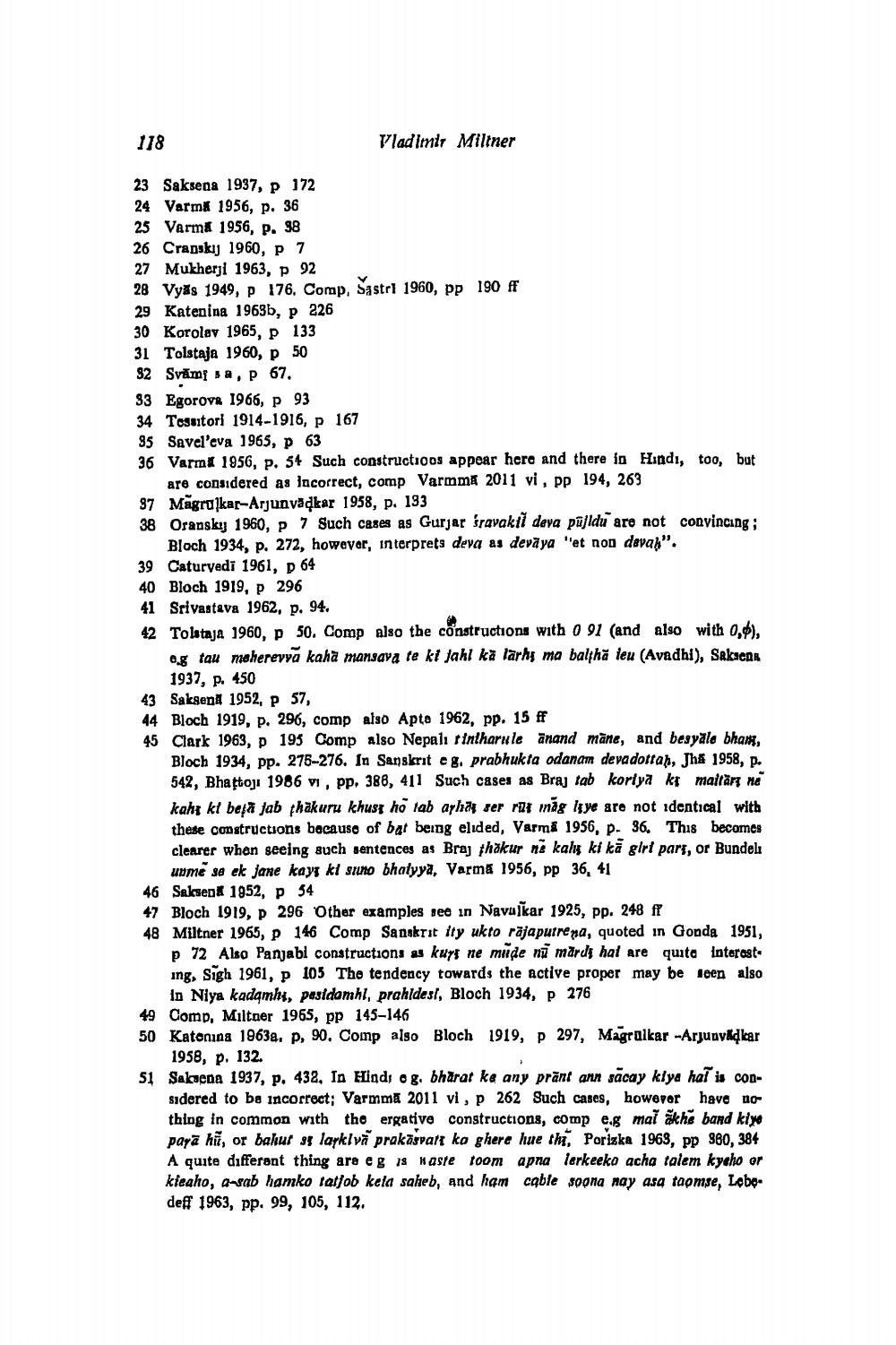________________
118
Vladimir Miltner
23 Saksena 1937, P 172 24 Varma 1956, p. 36 25 Varma 1956, p. 38 26 Crapskij 1960, p 7 27 Mukherji 1963, P 92 28 Vyds 1949, P 176. Comp, Sastri 1960, pp 190 FF 29 Katenina 1963b, p 226 30 Korolav 1965, p 133 31 Tolstaja 1960, p 50 S2 Svām sa, P 67. 33 Egorova 1966, p 93 34 Tosutori 1914-1916, p 167 35 Savel'eva 1965, p 63 36 Varmi 1956, p. 54 Such constructions appear here and there in Hindi, too, but
are considered as incorrect, comp Varmma 2011 vi, pp 194, 263 97 Mägruļkar-Arjunyädkar 1958, p. 133 38 Oransky 1960, p 7 Such cases as Gurjar sravakti deva pūjidu are not convincing ;
Bloch 1934, p. 272, however, interprets deva as devāya "et non deval". 39 Caturyedi 1961, p 64 40 Bloch 1919, p 296 41 Srivastava 1962, p. 94. 42 Tolstaja 1960, p 50. Comp also the constructions with 0 91 (and also with 0,4),
og tau moherevva kaha mansava te ki jakl ka larhy ma balthă leu (Avadhi), Saksena
1937, p. 450 43 Saksena 1952, P 57, 44 Bloch 1919, p. 296, comp also Apta 1962, pp. 15 ff 45 Clark 1963, P 195 Comp also Nepali tintharule anand māne, and besyale bhas,
Bloch 1934, pp. 275-276. In Sanskrit eg. prabhukta odanam devadottah, Jha 1958, p. 542, Bhattoji 1986 w, pp. 388, 411 Such cases as Braj tab kortya kt maitārt ne kaht kl bejā jab thakuru khust ho lab ayat ser ra mag liye are not identical with these constructions because of bat being elided, Varmi 1956, p. 36. This becomes clearer when seeing such sentences as Braj thakur ni kahy ki kā giri pars, or Bundeli
upmë se ek jane kaya ki suno bhalyya, Varma 1956, pp 36, 41 46 Salsen 1952, p 34 47 Bloch 1919, p 296 Other examples see in Navulkar 1925, pp. 248 fp 48 Miltner 1965, P 146 Comp Sanskrit ity ukto rājaputrena, quoted in Gonda 1951,
p 72 Also Panjabi constructions as kurs ne mude ni mardy hat are quite interest ing, sigh 1961, p105 The tendency towards the active proper may be seen also
in Niya kadamha, pasidomhl, prahldesl, Bloch 1934, p 276 49 Comp, Miltaer 1965, pp 145-146 50 Katonina 1963. p. 90. Comp also Bloch 1919, p 297, Magralkar -Arjunyadlar
1958, p. 132. 51 Saksena 1937, p. 432, In Hindi og. bharat ke any pränt ann sācay kiya hal is con
sidered to be incorrect; Varmma 2011 vi, p 262 Such cases, however have no thing in common with the ergative constructions, comp eg mai akhe band kiyo payā him, or bahut st lapklvä prokāspalt ko ghere hue thi, Porizka 1963, pp 960,384 A quite different thing are eg is waste toom apna Terkeeko acha talem kyeho or kleaho, annab hamko tatjob kela saheb, and ham cable soona nay asa taomse, Lebedeff 1963, pp. 99, 105, 112.
44 Bloch 1919P: 195 Comp also Nepales, prabhukte
apna terk
PP. 99, 105, 119 Kela sakeb, and tom




